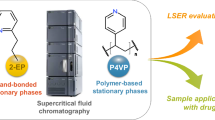Summary
Spherical porous silica particles (10 μm diameter, 300 Å and 80 Å pores), spherical nonporous silica particles (10 μm diameter), and irregular porous silica particles (≈10 μm diameter, 80 Å pores) were deactivated with polymethylhydrosiloxane (PS). The surface activities of the deactivated silica particles were investigated using various polar compounds under supercritical fluid chromatography (SFC) conditions (neat CO2), and compared with a commercial C18-bonded phase. The small pore (80 Å) silica particles could be more completely deactivated than larger pore (300 Å) and nonporous silica particles. The success of the PS deactivation method is ascribed to the excellent match between the reactive groups on the polymer backbone and the silica surface, and the formation of a highly crosslinked polymeric layer over the surface. Physical processes, such as adsorption and desorption of the deactivation reagent on the surface and diffusion from the surface, were found to have important effects on the deactivation. Using capillary columns packed with PS deactivated silica particles, typical polar organic compounds, including hydroxyl-containing compounds, carbonyl-containing compounds, free amines, and free carboxylic acids, were separated by SFC and compared with results from a commercial C18-bonded phase. While the results clearly show that the PS deactivated particles were more inert than the C18-bonded phase, better deactivation methods are still needed for separation of free acids and alkylamines.
Similar content being viewed by others
References
K. K. Unger, “Porous Silica”, Elsevier, Amsterdam, 1979.
V. A. Tertyk, A. A. Chuiko, V. M. Mashchenko, V. V. Pavlov, Russ. J. Phys. Chem.47, 85 (1973).
S. Kitagawa, T. Tsuda, J. Microcol. Sep.7, 59 (1995).
C. L. Woolley, K. E. Markides, M. L. Lee, K. D. Bartle, J. High Resolut. Chromatogr. Chromatogr. Commun.9, 506 (1986).
K. M. Payne, B. J. Tarbet, K. E. Markides, M. L. Lee, Anal. Chem.62, 1379 (1990).
A. Yu Fadeev, S. M. Staroverov, J. Chromatogr.47, 103 (1988).
S. M. Staroverov, A. A. Serdan, G. V. Lisichkin, J. Chromatogr.364, 377 (1988).
K. K. Unger, W. Messer, K. F. Krebs, J. Chromatogr.149, 1 (1978).
J. Kirkland, J. Chromatogr. Sci.10, 593 (1972).
C. F. Poole, S. K. Poole, “Chromatography Today”, Elsevier, Amsterdam, 1991, Chapter 4.
A. Malik, W. Li, M. L. Lee, J. Microcol. Sep.5, 365 (1993).
F. Liebay, “Structural Chemistry of Silicates”, Springer-Verlag, Germany, 1985.
M. T. Gilbert, “High Performance Liquid Chromatography”, Wright, Bristol, 1987, p. 66.
Y. Takayama, J. Chromatogr.178, 63 (1979).
V. A. Tertykh, A. A. Chuiko, V. M. Maschenko, V. V. Pavlov, Russ. J. Phys. Chem.47, 85 (1973).
F. O. Stark, O. K. Johannson, G. E. Vogel, R. G. Chaffee, R. M. Lacefield, J. Phys Chem.72, 2750 (1968).
B. Evans, T. E. White, J. Catal.11, 336 (1968).
Y. Shen, A. Malik, W. Li, M. L. Lee, J. Chromatogr. A.,707, 303 (1995).
Author information
Authors and Affiliations
Rights and permissions
About this article
Cite this article
Shen, Y., Lee, M.L. Polymethylhydrosiloxane surface deactivation of silica particles for packed capillary column supercritical fluid chromatography. Chromatographia 41, 665–670 (1995). https://doi.org/10.1007/BF02267802
Received:
Accepted:
Issue Date:
DOI: https://doi.org/10.1007/BF02267802




